Complete Solutions to MCQs of chapter ELECTROCHEMISTRY of Class 12 book with complete answers and questions
| Class 12 | CHEMISTRY |
| Chapter | ELECTROCHEMISTRY |
| NCERT FINGERTIPS | MCQs |
| Number Of Questions | 97 |
| Academic Year | 2023-24 |
In a Daniel cell,
View SolutionWhich of the following statement is correct about the given Daniell cell?

View SolutionGiven below are two figures of Daniell cell (X) and (y). Study the figures and mark the incorrect statement from the following.
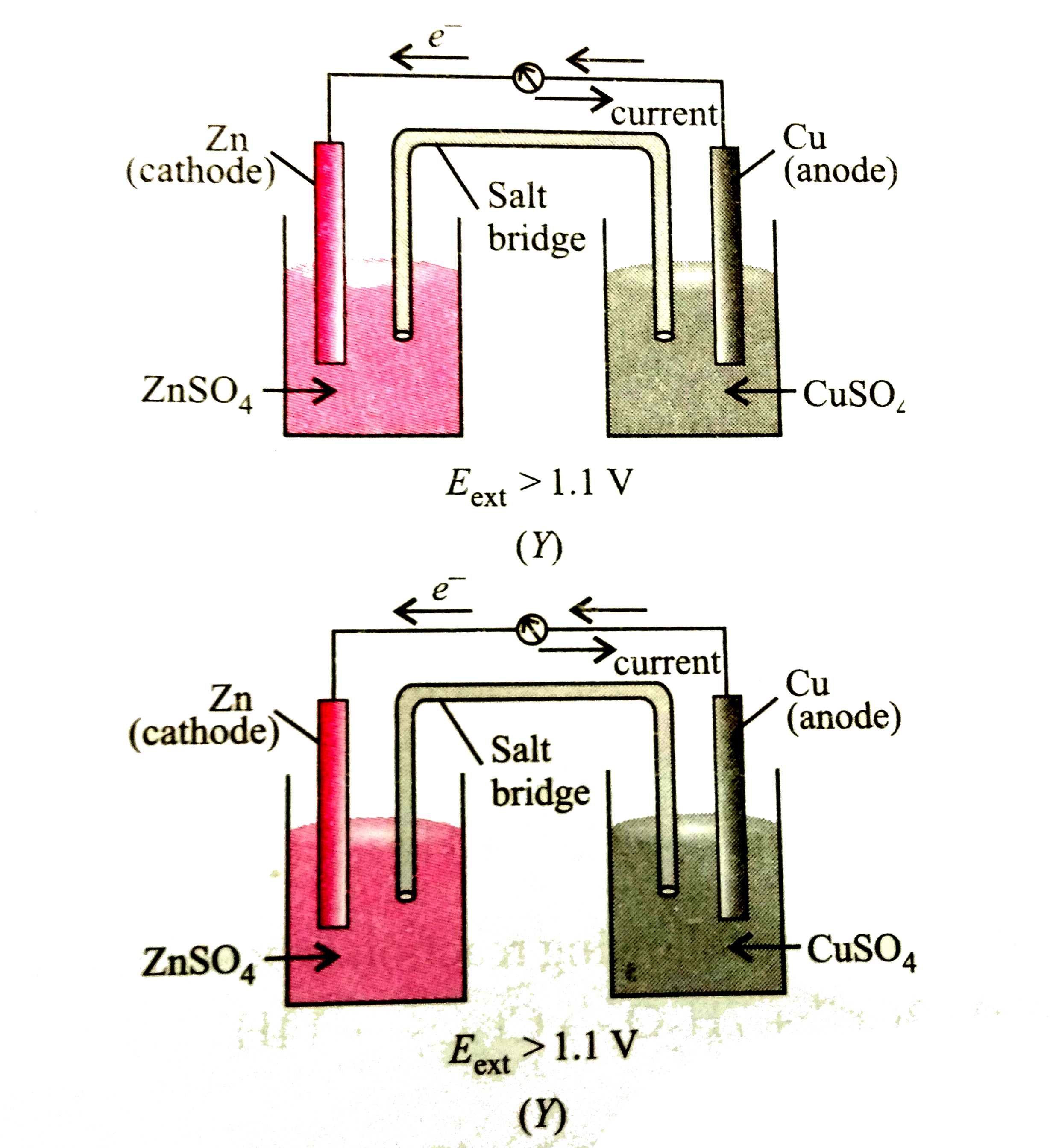
View SolutionA galvanic cell has electrical potential of 1.1 V . If an opposing potential of 1.1 V is applied to this cell, what will happen to the cell reaction and current flowing through the cell ?
View SolutionFollowing reactions are taking place in a Galvanic cell , `Zn to Zn^(2+) + 2e^(-) , Ag^(+) + e^(-) to Ag`
Which of the given representations is the correct method of depicting the cell ?
View SolutionWhich of the following is the correct cell representation for the given cell reaction ?
`Zn+H_2SO_4 to ZnSO_4 + H_2`
View SolutionThe cell reaction of the galvanic cell : `Cu_((s))|Cu_((aq))^(2+) ||Hg_((aq))^(2+) |Hg_((l))` is
View SolutionWhich of the following reaction is possible at anode ?
View SolutionIn the cell `Zn|Zn^(2+)||Cu^(2+)|Cu`, the negaitve terminal is
View SolutionFor the galvanic cell, `Cu|Cu^(2+)"||"Ag^(+)|Ag`. Which of the following observations is not correct ?
View SolutionWhich of the following is the cell reaction that occurs when the following half-cells are combined?
`I_2 + 2e^(-) to 2I^(-) (1M) , E^@=+0.54 V`
`Br_2+2e^(-) to 2Br (1 M) , E^@=+1.09 V`
View SolutionCalculate the standard cell potential of galvanic cell in which the following reaction takes place
`2Cr_(s)+3Cd_(aq)^(+2)rarr2cr_(aq)^(+3)+3Cd_(s)`
Given `E_(Cr^(+3)//Cr)=-0.74(V)E^(@)_(Cd^(+2)//Cd)=-0.04(V)`
View SolutionThe standard reduction potential for the half-cell reaction,`Cl_2 + 2e^(-) to 2Cl^(-)` will be `(Pt^(2+)+2Cl^(-)to Pt + Cl_2 , E_"cell"^@=-0.15 V , Pt^(2+) + 2e^(-) to Pt, E^@=1.20 V)`
View SolutionIn a cell reaction, `Cu_((s))+ 2Ag_((aq))^(+) to Cu_((aq))^(2+) + 2Ag_((s)) E_"cell"^@`=+0.46 V . If the concentration of `Cu^(2+)` ions is doubled then `E_"cell"^@` will be
View SolutionA standard hydrogen electrode has zero electrode potential because :
View SolutionObserve the given diagram and fill in the blanks by choosing the correct option.
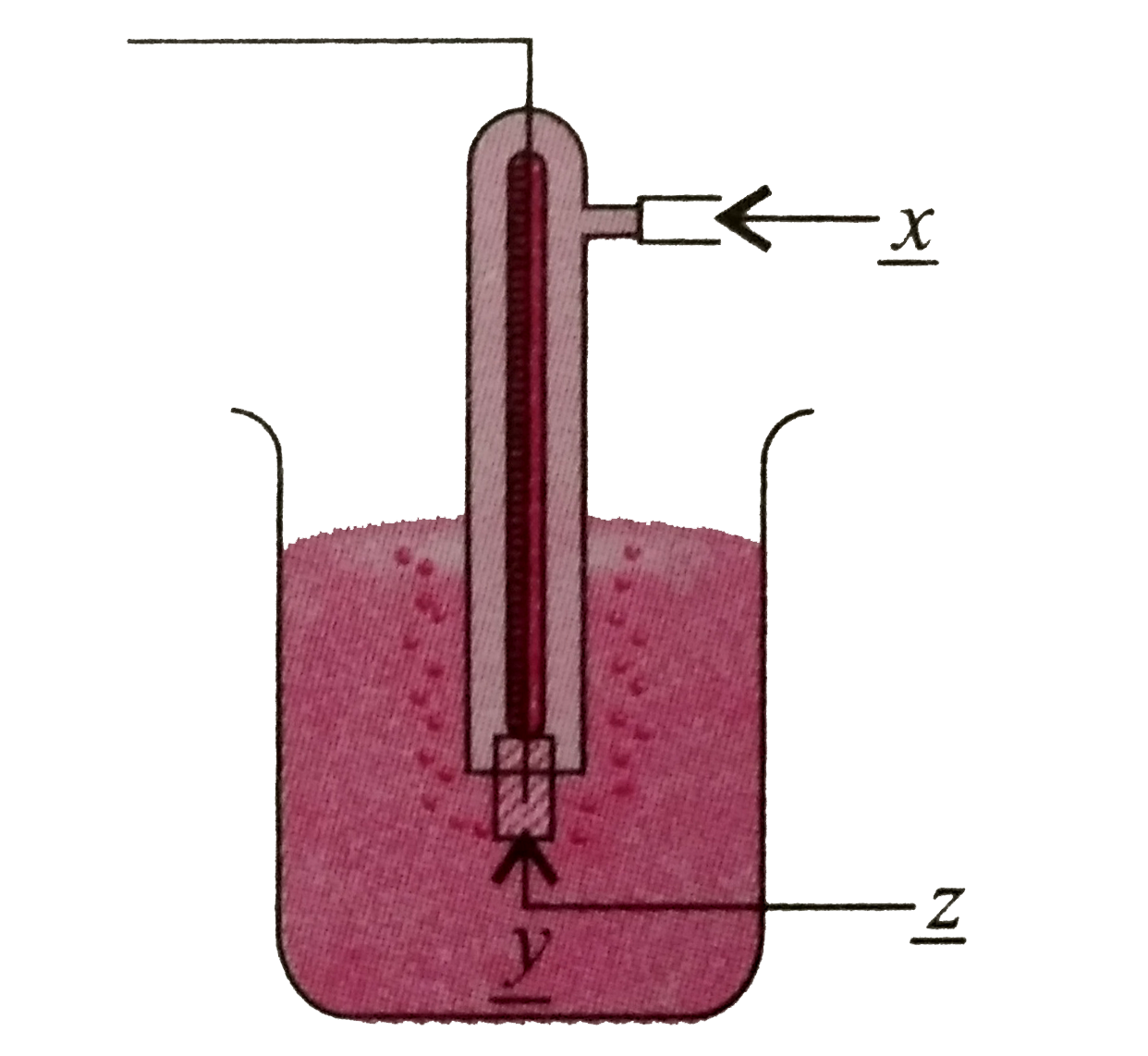
View SolutionA cell is set up as shown in the figure. It is observed that EMF of the cell comes out to be 2.36 V. Which of the given statements is not correct about the cell?
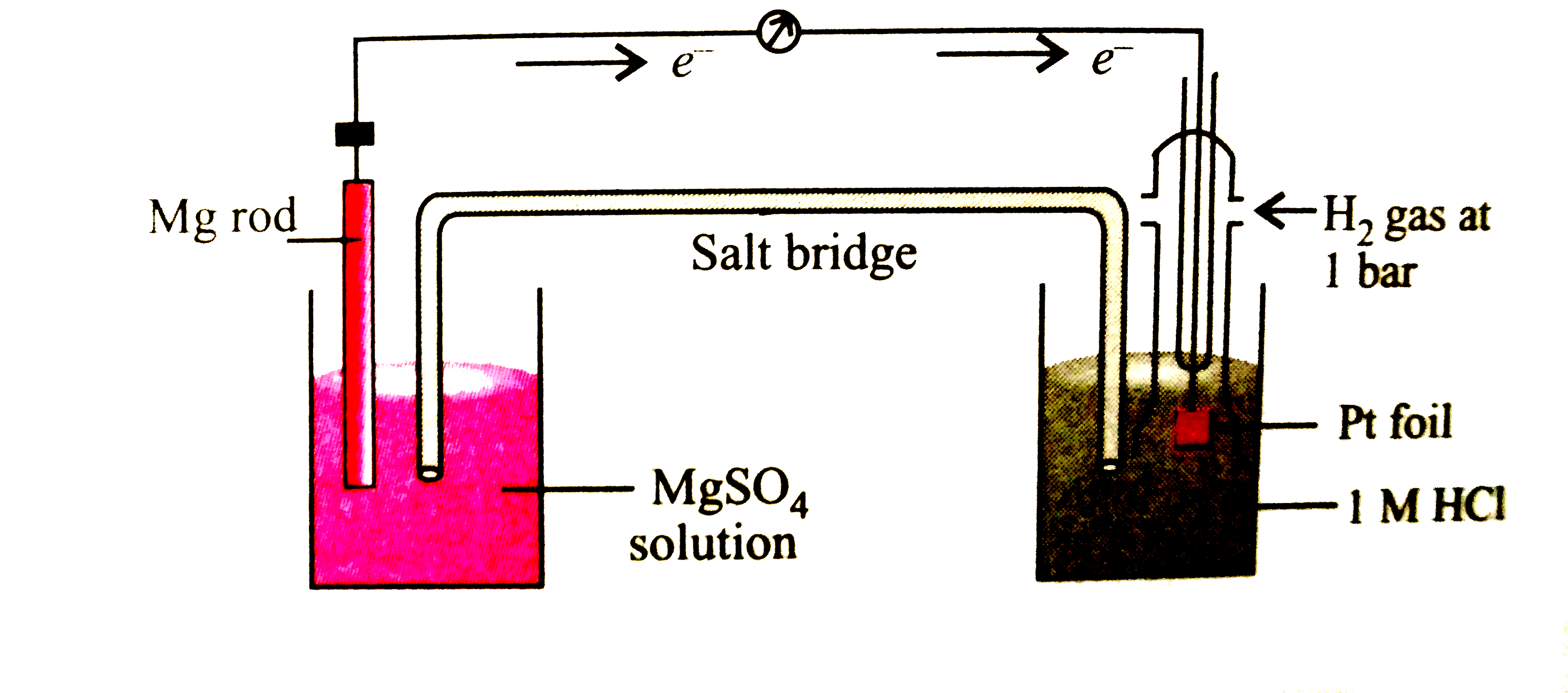
View SolutionWhich of the following is thecorrect order in which metals displace each other from the salt solution of their salts?
View SolutionGiven below are the standard electrode potentials of few half-cells. The correct order of these metals in increasing reducing power will be `K^(+)//K`=-2.93 V , `Ag^+` /Ag=0.80 V, `Mg^(2+)`/Mg=-2.37 V, `Cr^(3+)`/Cr =-0.74 V
View SolutionBased on the data given below, the correcy order of reducing power is:
`Fe_((aq.))^(3+) + e rarr Fe_((aq.))^(2+), E^(@) = +0.77 V`
`Al_((aq.))^(3+) + 3e rarr Al_((s)), E^(@) = -1.66 V`
`Br_(2(aq.)) + 2e rarr 2Br_((aq.))^(-), E^(@) = +1.08 V`
View Solution`Zn` gives `H_(2)` gas with `H_(2)SO_(4)` and `HCl` but not with `HNO_(3)` because
View SolutionFluorine is the best oxidising agent because it has
View SolutionWhich of the following is not an application of electrochemical series?
View Solution`E^@` values of three metals are listed below.
`{:(Zn_((aq))^(2+) + 2e^(-) to Zn_((s)),, E^@=-0.76V),(Fe_((aq))^(2+) + 2e^(-) to 2Fe(s) , , E^@=-0.44 V),(Sn_((aq))^(2+)+2e^(-) to Sn_((s)) ,, E^@=-0.14 V) :}`
Which of the following statements are correct on the basis of the above information ?
(i)Zinc will be corroded in preference to iron if zinc coating is broken on the surface.
(ii)If iron is coated with tin and the coating is broken on the surface then iron will be corroded .
(iii)Zinc is more reactive than iron but tin is less reactive then iron.
View SolutionFor a cell reaction : `M^(n+)(aq)+"ne"^(-) to M(s)`, the Nernst equation for electrode potential at any concertation measured with respect to standard hydrogen electrode is represented as
View SolutionAt `25^@C`, Nernst equation is
View SolutionMark the correct Nernst equation for the given cell. `F_((s))|Fe^(2+)(0.001 M) ||H^(+)(1M) | H_(2(g)) ( 1 bar ) | Pt_((s))` is
View SolutionThe correct Nernst equation for the given cell `Pt_((s)) | Br_(2(l)) | Br^(-) (M) || H^(+) (M) |H_(2(g)) (1bar) | Pt_((s))` is
View SolutionGiven below are few reactions with some expressions. Mark the expressions which is not correctly matched.
View SolutionCalculate the emf of the following concentration cell at `25^(@)C`:
`Ag(s)|AgNO_(3) (0.01 M)||AgNO_(3) (0.05 M)|Ag (s)`
View SolutionThe standard reduction potential for `Cu^(2+)//Cu` is `+0.34V`. Calculate the reduction potential at pH=14 for the above couple. `K_(SP)` of `Cu(OH)_(2)` is `1.0xx10^(-19)`
View SolutionCalculate the reduction potential for the following half cell reaction at 298 K.
`Ag^(+)(aq)+e^(-)toAg(s)`
`"Given that" [Ag^(+)]=0.1 M and E^(@)=+0.80 V`
View SolutionMark the incorrect relationship from the following:
View SolutionThe standard emf for the cell reaction,
`2Cu^(+)(aq)toCu(s)+Cu^(2+)(aq)`
is `0.36V` at `298K`. The equilibrium constant of the reaction is
View Solution`E_"cell"^@` for the reaction , `2H_2O to H_3O^(+) + OH^(-)` at `25^@C` is -0.8277 V. The equilibrium constant for the reaction is
View SolutionCell reactiomn is spontaneous when
View Solution`Delta_rG^@` for the cell with the cell reaction : `Zn_((s))+ Ag_2O_((s)) + H_2O_((l)) to Zn_((aq))^(2+) + 2Ag_((s)) + 2OH_((aq))^(-)`
`[E_(Ag_2O // Ag)^(@)=0.344 V, E_(Zn^(2+)//Zn)^@=-0.76 V]`
View Solution`E^@` value of `Ni^(2+)//Ni` is -0.25 V and `Ag^+ //Ag` is +0.80 V . If a cell is made by taking the two electrodes what is the feasibility of the reaction?
View SolutionThe Gibbs energy for the decomposition of `Al_(2)O_(3)` at `500^(@)C` is as follows:
`(2)/(3)Al_(2)O_(3) rarr (4)/(3)Al + O_(2), Delta_(r)G = +966kJ mol^(-1)`
The potential difference needed for electrolytic reeduction of `Al_(2)O_(3)` at `500^(@)C` is at least:
View Solution`E^@` values for the half cell reactions are given below :
`Cu^(2+) + e^(-) to Cu^(+) , E^@`=0.15 V
`Cu^(2+) + 2e^(-) to Cu, E^@`=0.34 V
What will be the `E^@` of the half-cell : `Cu^(+) + e^(-) to Cu` ?
View SolutionCalculate `DeltaG^(@)` for the reaction : `Cu^(2+)(aq) +Fe(s) hArr Fe^(2+)(aq) +Cu(s)`. Given that `E^(@)Cu^(2+)//Cu = 0.34 V`,
`E_(Fe^(+2)//Fe)^(@) =- 0.44 V`
View SolutionThe specific conductivity of N/10 KCl solution at `20^(@)C` is `0.0212 ohm^(-1) cm^(-1)` and the resistance of the cell containing this solution at `20^(@)C` is 55 ohm. The cell constant is :
View SolutionElectrical conductance through metals is called metallic or electronic conuctance and is due to the movement of electrons. The electronic conductance depends on
View SolutionFill in the blanks with appropriate words.
The electrolytic solution is always neutral because the total charge on __(i)___ is equal to __(ii)__ on ___(iii)___ .Unlike the metallic conductor, the electrolyte conducts the electric current by virtue of movement of its ___(iv)___ . The property due to which a metal tends to go into solution in term of positive ions is known as ___(v)__.
(i),(ii),(iii),(iv) and (v ) respectively are
View SolutionWhat would be the equivalent conductivity of a cell in which 0.5 salt solution offers a resistance of 40 ohm whose electrodes are 2 cm apart and 5 `cm^2` in area?
View SolutionUnits of the properties measured are given below. Which of the properties has not been matched correctly?
View SolutionMolar conductivity of 0.15 M solution of KCI at 298 K, if its conductivity is 0.0152 S `cm^(-1)` will be
View SolutionThe molar conductivity is maximum for the solution of concentration __________.
View SolutionThe specific conductance of a saturated solution of AgCl at `25^@C` is `1.821xx10^(-5)` mho `cm^(-1)`. What is the solubility of AgCl in water (in g `L^(-1)` ) , if limiting molar conductivity of AgCl is 130.26 mho `cm^(2) mol^(-1)` ?
View SolutionSpecific conductance of 0.1 M NaCl solution is `1.01xx10^(-2) ohm^(-1) cm^(-1)` . Its molar conductance in `ohm^(-1) cm^(2) mol^(-1)` is
View SolutionThe variation in `Lambda_m` with concentration for a strong electrolyte can be represented by the equation, `Lambda_m=Lambda_m^@ -AC^(1//2)` The value of constant A for a given solvent and temperature depends upon the type of electrolyte i.e., cations and anions produced on dissociation of electrolyte in the solution .
NaCl, `MgCl_2` and `CaSO_4` are known as
View SolutionThe variation in `Lambda_m` with concentration for a strong electrolyte can be represented by the equation, `Lambda_m=Lambda_m^@ -AC^(1//2)` The value of constant A for a given solvent and temperature depends upon the type of electrolyte i.e., cations and anions produced on dissociation of electrolyte in the solution .
Which of the following statements is correct regarding variations of molar conductivity with concentration.
View SolutionTwo solutions of X and Y electrolytes are taken in two beakers and diluted by adding 500mL of water. `Lambda_m` of X increases by 1.5 times while that of Y increases by 20 times, what could be the eletrolytes X and Y?
View SolutionWhen water is added to an aqueous solution of an electrolyte, what is the change in specific conductivity of the electrolyte?
View SolutionMark the correct choice of electrolytes represented in the graph.
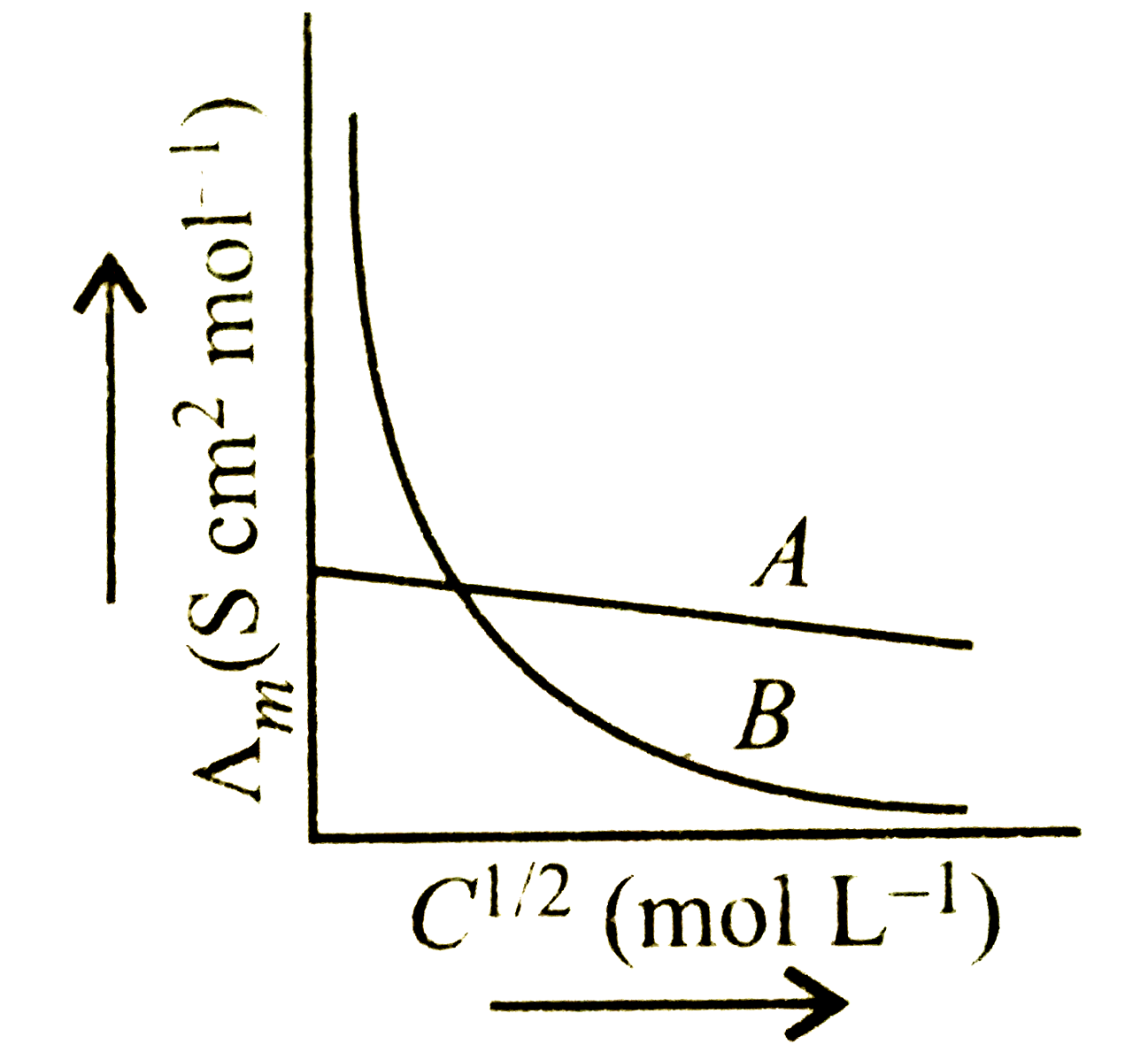
View SolutionMolar conductivity of `NH_4OH` can be calculated by the equation.
View SolutionLimiting molar conductivity of NaBr is
View SolutionWhat will be the molar conductivity of Al 3+ ions at infinite dilution if molar conductivity of `Al^(2) (SO_(4))_(3)` is 858 S `cm^(2)` `"mol" ^(-1)` and ionic conductance of `SO_(4)^(2-)` is 160 S `cm^(2) "mol" ^(-1)` at infinite dilution ?
View SolutionLimiting molar conductivity for some ions is given below (in S `cm^(2) mol^(-1)` ) :
`Na^+ -50.1 , Cl^(-) - 76.3 , H^(+) - 349.6 , CH_3COO^(-) -40.9 , Ca^(2+) -119.0`
What will be the limiting molar conductivities `(Lambda_m^@)` of `CaCl_2, CH_3COONa ` and NaCl respectively ?
View SolutionThe equivalent conductivity of N/10 solution of acitic acid at `25^(@)C` is `14.3 ohm^(-1) cm^(2) eq^(-1)`. Calculate the degree of dissociation of `CH_(3)COOH` if `Lambda_(oo CH_(3)COOH)` is 390.71.
View SolutionThe molar conducatance of `Ba^(2+)` and `Cl^(-)` are `127` and `76 ohm^(-1) cm^(-1) mol^(-1)` respectively at infinite dilution. The equivalent conductance of `BaCl_(2)` at infinte dilution will be
View SolutionThe molar conductivity of `0.025 mol L^(-1)` methanoic acid is `46.1 S cm^(2) mol^(-1)`. Its degree of dissociation `(alpha)` and dissociation constant. Given `lambda^(@)(H^(+))=349.6 S cm^(-1)` and `lambda^(@)(HCOO^(-)) = 54.6 S cm^(2) mol^(-1)`.
View SolutionA weak monobasic acid is 5% dissociated in 0.01 mol `dm^(-3)` solution. The limiting molar conductivity at infinite dilution is `4.00xx10^(-2) ohm^(-1) m^(2) mol^(-1)`. Calculate the conductivity of a 0.05 mol `dm^(-3)` solution of the acid.
View SolutionIn the electrolytic cell, flow of electrons is from:
View SolutionMatch the column I with column II and mark the appropriate choice.
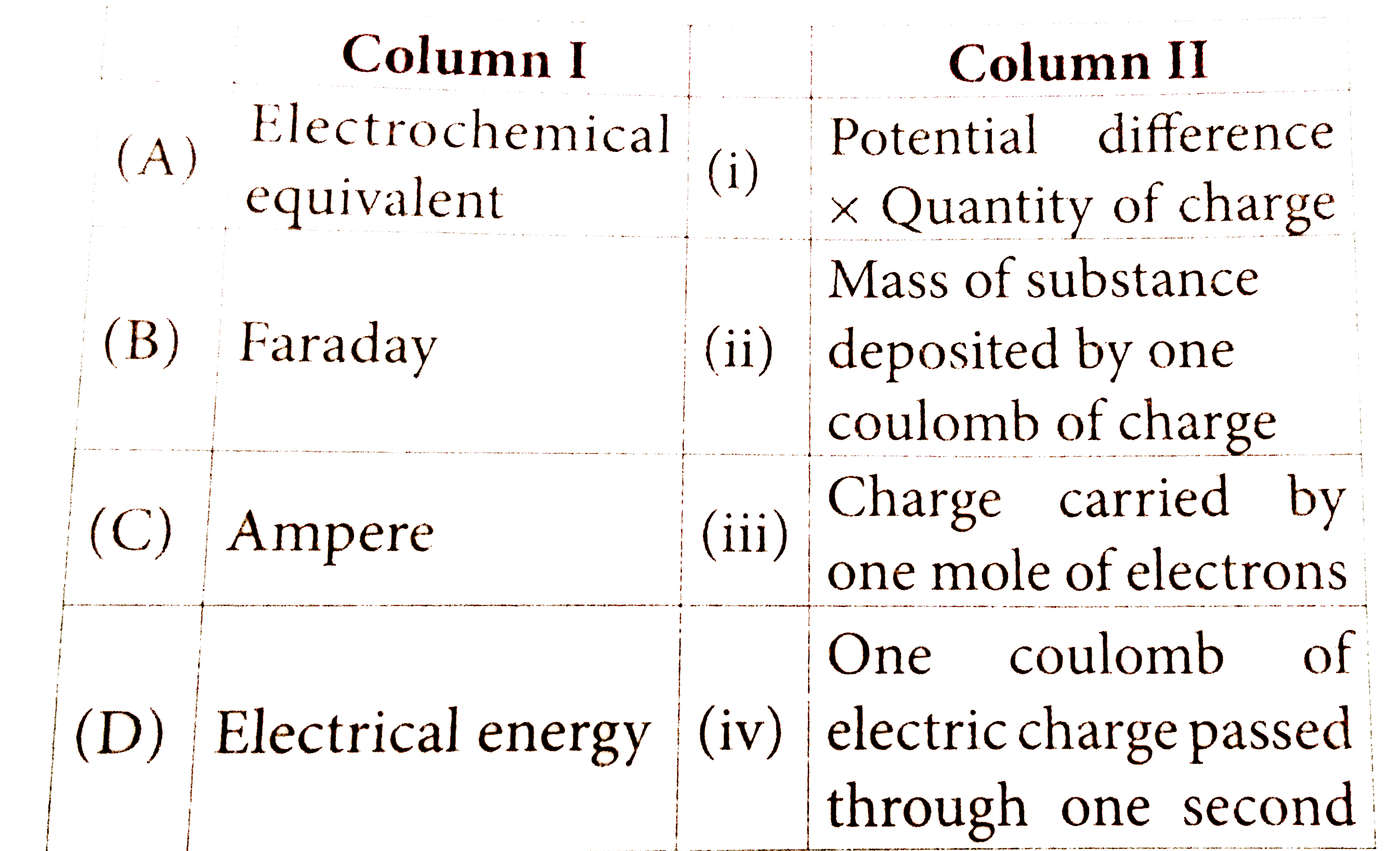
View SolutionHow long does it take to deposit 100 g of Al from an electrolytic cell containing `Al_(2)O_(3)` using a current of 125 ampere ?
View SolutionThe charge required for reducing 1 mole of `MnO_4^(-)` to `Mn^(2+)` is
View SolutionHow much electricity in terms of Faraday is required to produce 100 g of Ca from molten `CaCl_2` ?
View SolutionIf a current of 1.5 ampere flows through a metallic wire for 3 hours, then how many electrons would flow through the wire?
View SolutionHow many coulombs of electricity is required to reduce 1 mole of `Cr_2O_7^(2-)` in acidic medium?
View SolutionAn electric charge of 5 Faradays is passed through three electrolytes `AgNO_3, CuSO_4` and `FeCl_3` solution. The grams of each metal liberted at cathode will be
View SolutionA current of 1.40 ampere is passed through 500 mL of 0.180 M solution of zinc sulphate for 200 seconds. What will be the molarity of `Zn^(2+)` ions after deposition of zinc?
View SolutionHow much time is required to deposit `1xx10^(-3)` cm thick layer of silver (density is 1.05 g `cm^(-3)` ) on a surface of area 100 `cm^2` by passing a current of 5 A through `AgNO_3` solution?
View SolutionHow much metal will be deposited when a current of 12 ampere with 75% efficiency is passed through the cell for 3 h? (Given: Z= `4xx10^(-4)` )
View SolutionSame amount of electric current is passed through the solutions of `AgNO_3` and HCI. If 1.08 g of silver is obtained from `AgNO_3` solution. The amount of hydrogen liberted at STP will be
View SolutionWhen during electrolusis of a solution of `AgNO_3, 9650` coulmbs of charge pass through the electroplationg bath, the mass of silver deposited on the cathode will be:
View SolutionThe amount of chlorine evolved by passing 2 A of current in an aqueous solution of NaCI for 30 minutes is
View SolutionHow many moles of Pt may be deposited on the cathode when 0.80F of electricity is passed through 1.0M solution of `Pt^(4+)`?
View SolutionAn electric current is passed through silver nitrate solution using silver electrodes. 15.28 g of silver was found to be deposited on catode. What will be the weight of copper deposited on cathode if same amount of electricity is passed through copper sulphate solution using copper electrodes?
View SolutionIf 54 g of silver is deposited during an electrolysis reaction, how much aluminium will be deposited by the same amount of electric current?
View SolutionAn acidic solution of `Cu^(2+)` ions containing 0.4 g of `Cu^(2+)` ions is electrolysed until all the copper is deposited. Calculate the volume of oxygen evolved at N.T.P.
View SolutionChoose the option with correct words to fill in the blanks.
According to preferential discharge theory, out of number of ions the one which requires ____ energy will be liberted ____ at a given electrode.
View SolutionWhich of the following statement is true?
View SolutionDuring the electrolysis of dilute sulphuric acid, the following process is possible at anode.
View SolutionIn electrolysis of dilute `H_(2)SO_(4)` what is liberated at anode?
View SolutionWhen an aqueous solution of `AgNO_3` is electroysed between platinum electrodes, the substances liberted at anode and cathode are
View SolutionElectrolysis of an aqueous solution of `AgNO_3` with silver electrodes produce __(i)___ at cathode while ___(ii)___ ions are dissolved from anode. When Pt electrodes are used ____(iii)___ is produced at anode ___(iv)___ at cathode.
View SolutionLabel the parts represented by (A), (B) and C
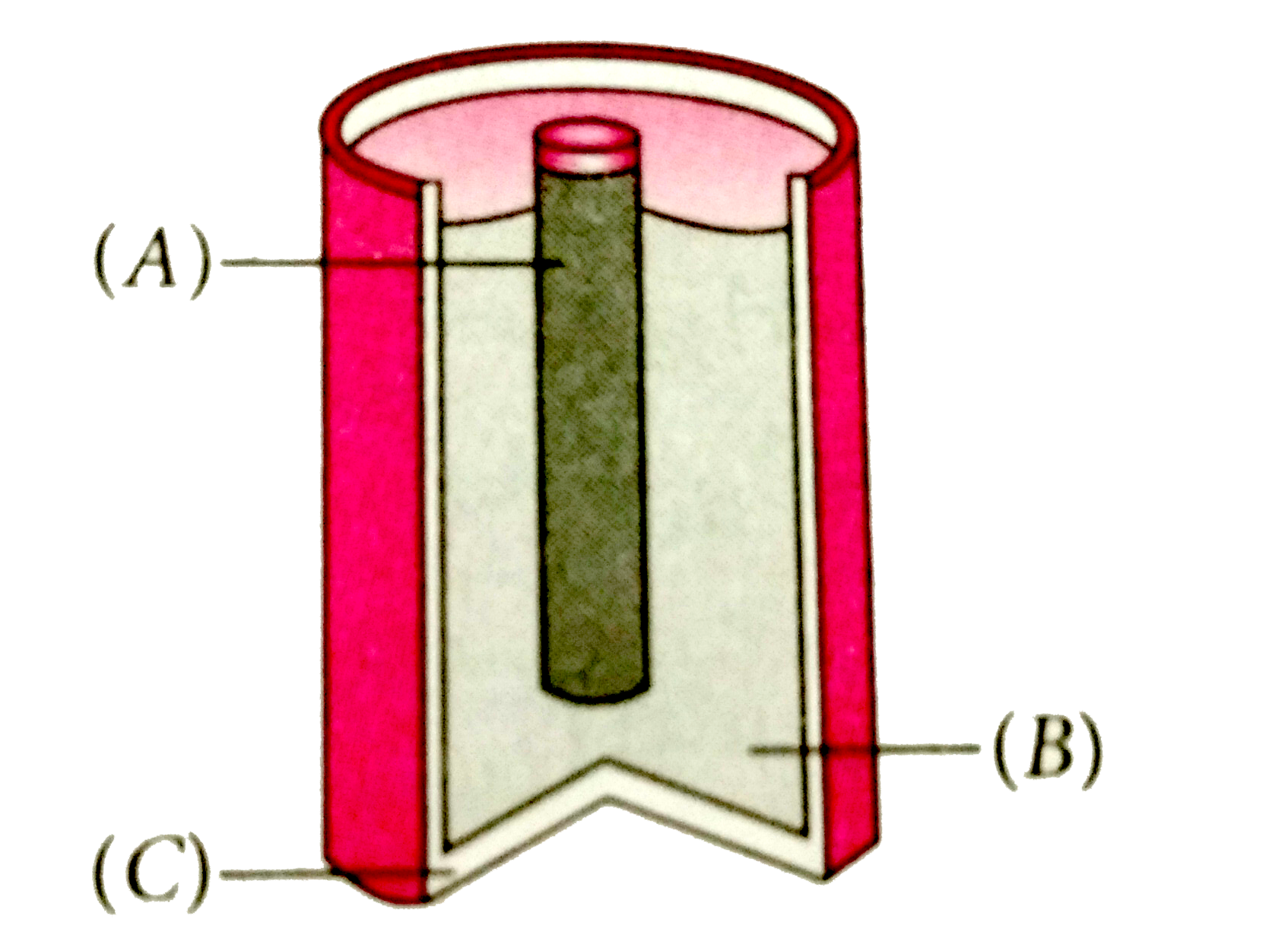
View SolutionWhich of the given statements for mercury cell are incorrect?
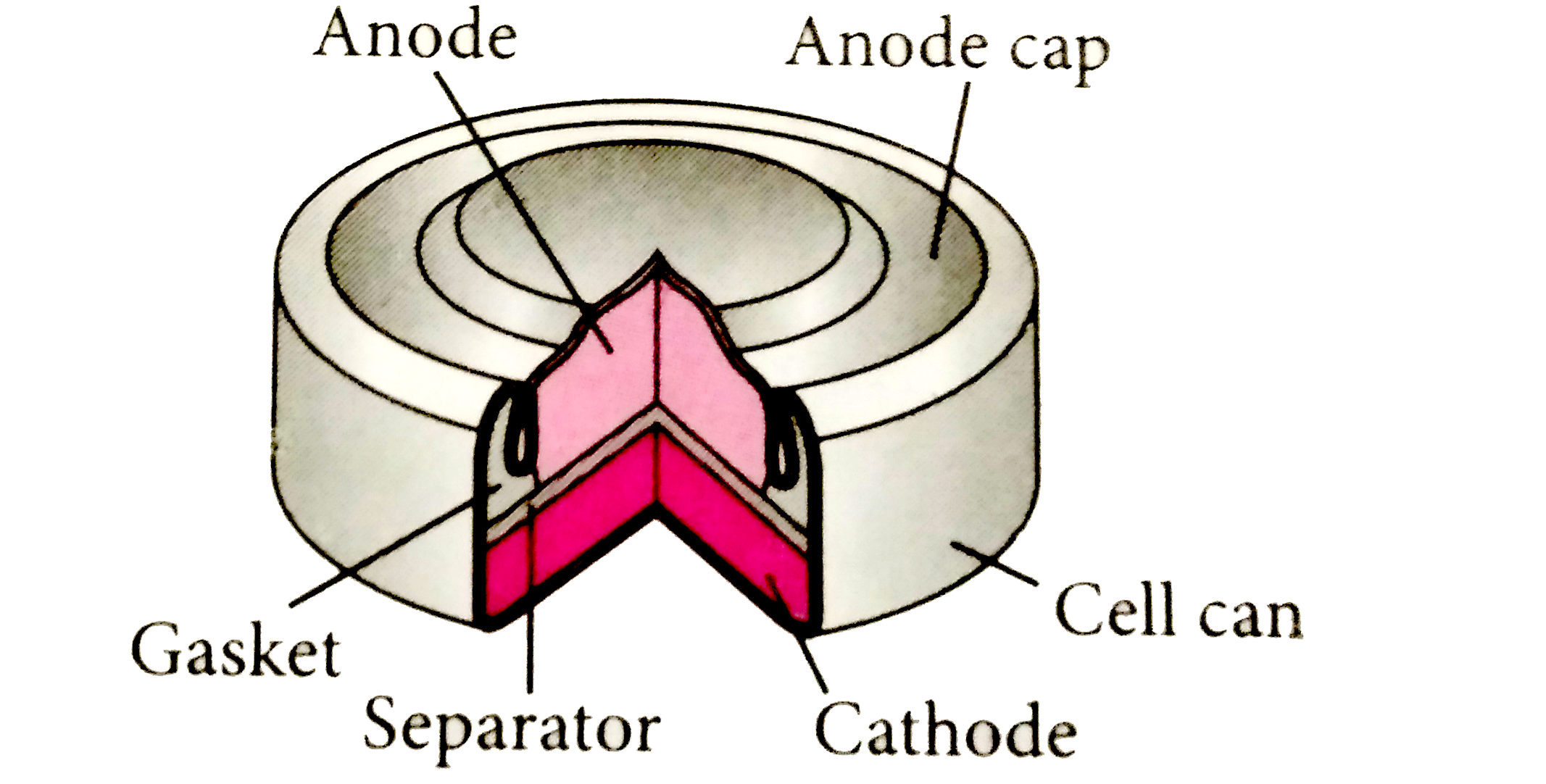
(i)Mercury cell is suitable for low current devices like hearing aids, watches, etc.
(ii)It consists of zinc-mercury amalgam as anode and a paste of HgO and carbon as the cathode.
(iii)The electrolyte is a paste of `Zn(OH)_2` and `KO_2`.
(iv)The electrolyte reactions for the cell are At anode : `Zn(Hg)+ H_2O to ZnO_((s)) + 2OH^(-) + 2e^(-)`
At cathode : `HgO + H_2O + 2e^(-) to Hg_((l)) + 2OH^-`
View SolutionLabel the given diagram showing lead storage battery :
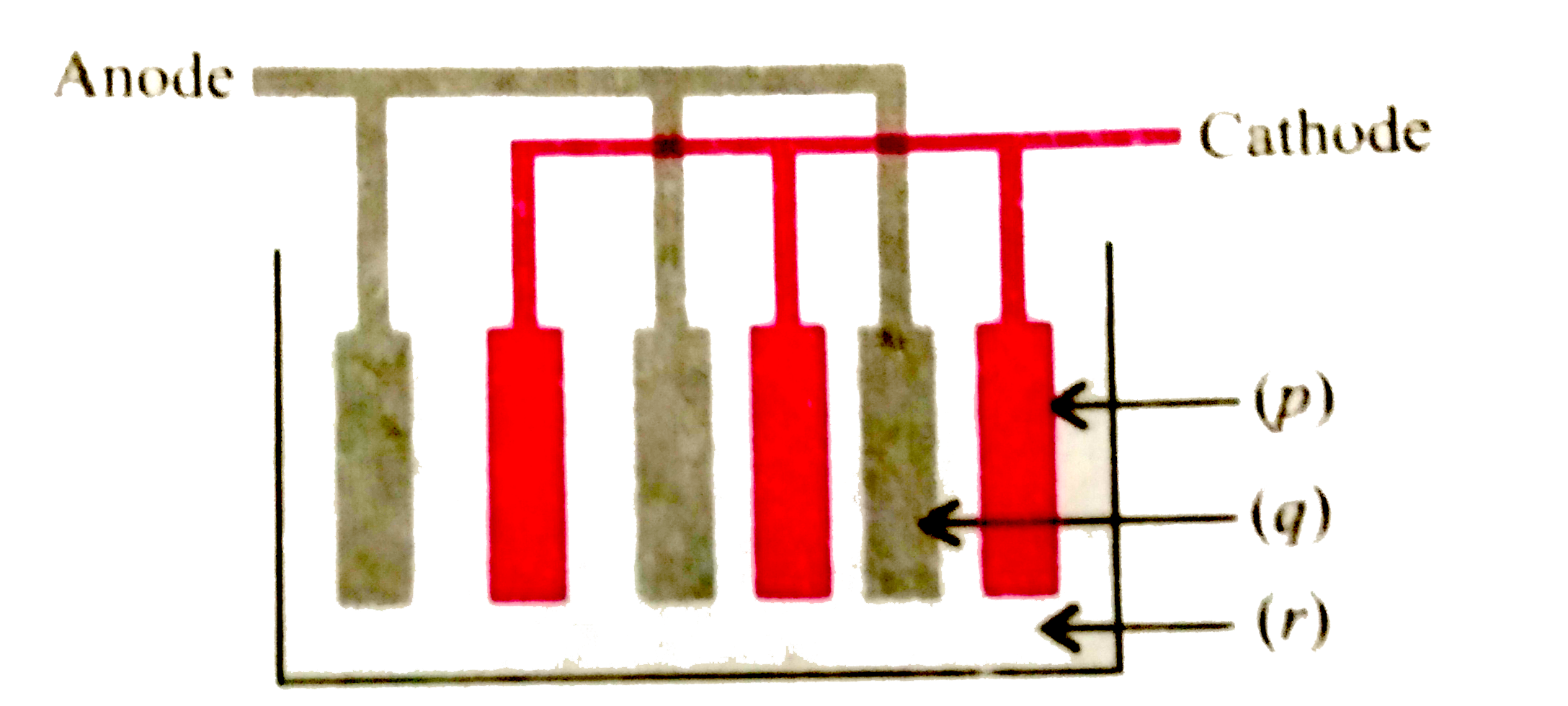
View SolutionWhen a lead storage battery is discharged
View SolutionThe reaction which is taking place in nickel cadmium battery can be represented by which of the following equations?
View SolutionStudy the given cell carefully and fill in the blanks by choosing an appropriate option.
In the given cell, hydrogen and oxygen are bubbled through porous ___(i)___ electrodes into concontrated aqueous ____(ii)___ solution. Catalysts like finely dividend __(iii)__ or ___(iv)___ metal are incorporated into the electrodes for increasing the rate of electrode reactions.
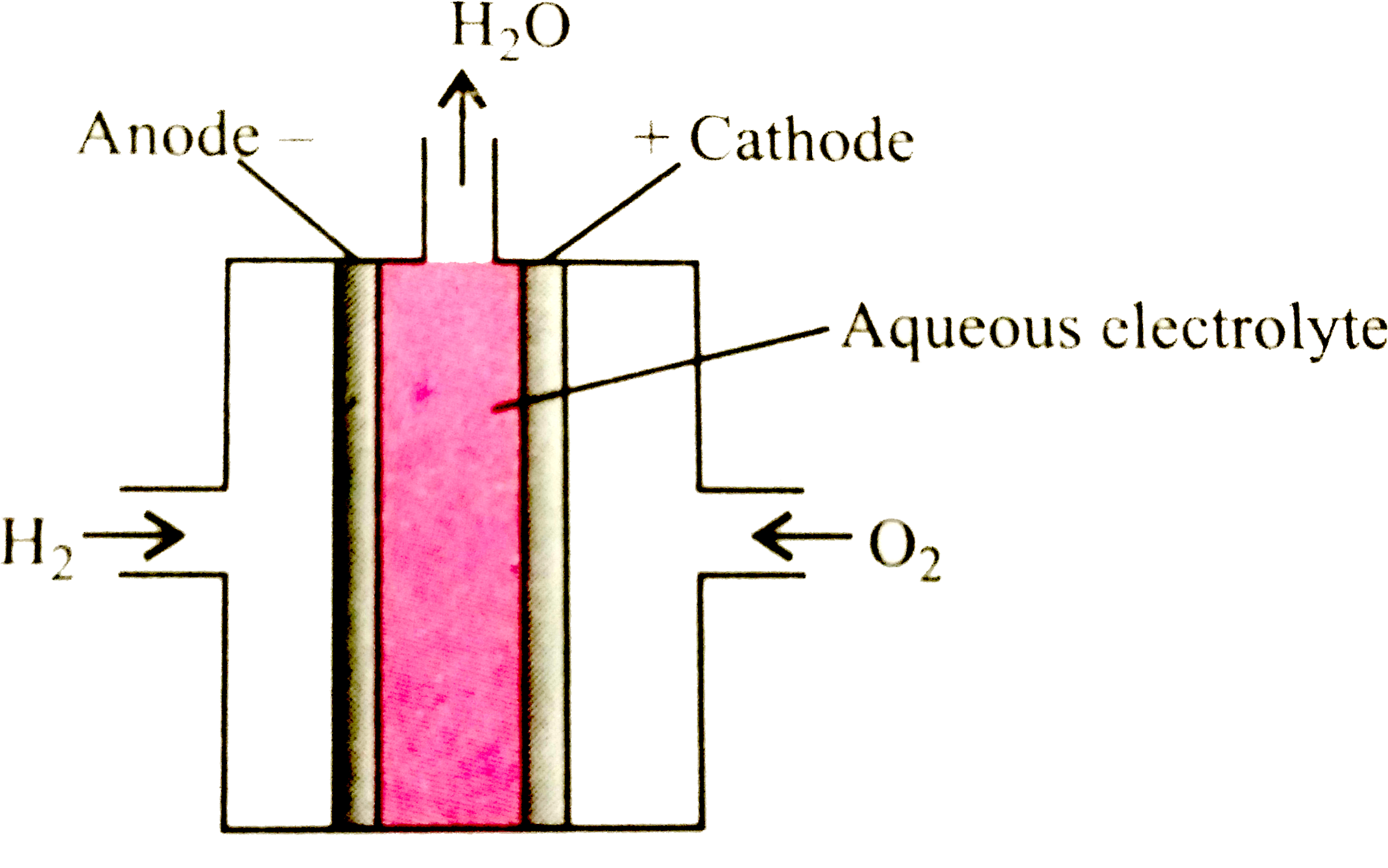
View SolutionThe overall reactions of a hydrogen -oxygen fuel cell is
View SolutionThe given figure shows the corrosion of iron in atmosphere.
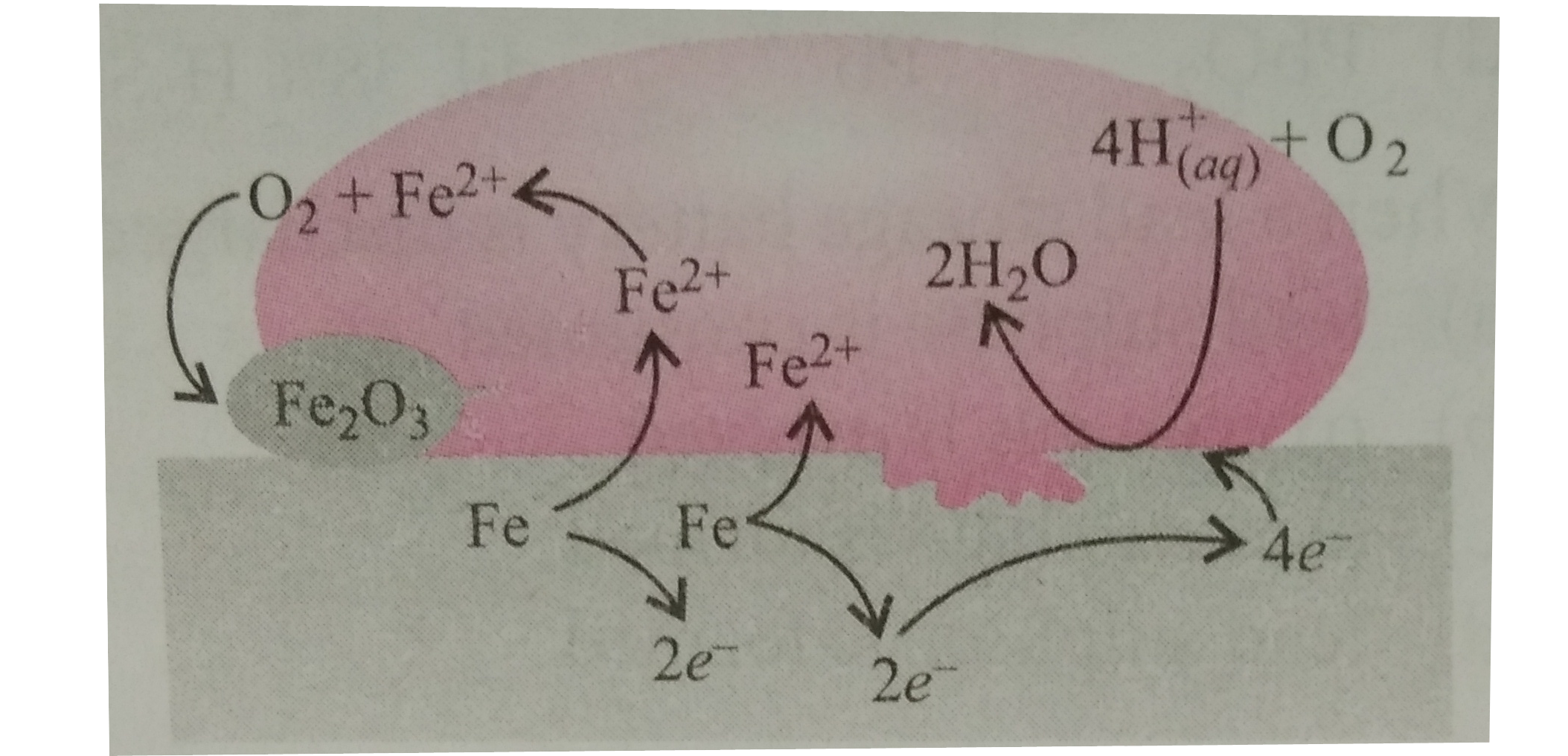
Fill in the blanks by choosing an appropriate option.
At a particular spot of an object made of iron, ___(i)___ of iron to ferrous ion takes place and that spot behaves as ___(ii)___. Electrons released at anodic spot move through the metal and go to another spot on the metal and reduce oxygen in presence of `H^+` . This spot behaves as ___(iii)___. The ferrous ions are further oxidised by atmospheric oxygen to ferric ions which come out as rust, __(iv)____ and with further production of ____(v)__ ions.
View SolutionWhich of the following reactions does not take place during rusting?
View SolutionMatch the column I with column II and mark the appropriate choice.

View Solution
MCQs questions and complete solutions for chapter ELECTROCHEMISTRY of MTG CHEMISTRY (ENGLISH) of Class 12